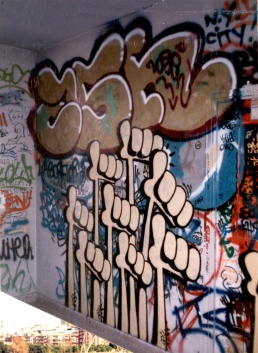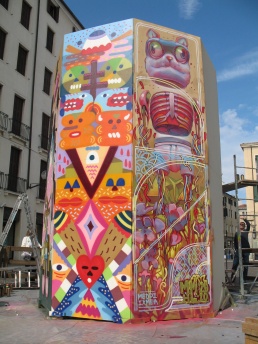This is Zosen Bandido
Interview by Crist Espiritu.
Artworks by Zosen Bandido.
Let us talk about your roots. Where do you hail from?
I was born in Buenos Aires, Argentina but I’ve been living in Barcelona since the beginning of the 90’s.
Give us a bit of your history. When did you start doing art?
I started doing graffiti in 1990 writing my name with my friends. I grew up in the graffiti culture, painting on trains and walls and then started to paint on canvas. It was a natural way to combine spray cans with brushes. My interest for another cultures and art expressions evolve with the pass of the years.
Tell us a bit of how you got into street art.
Before I discovered the graffiti movement, I was involved in skate culture. My passion for illustration came from old school skateboard graphics and vinyl covers.
Nobody called it “Street art” during the 90’s. This label came after with the internet. My style of painting letters was changing at the end of the century. I developed interest for another artists outside the graffiti word like Dubuffet, CoBrA movement, Paul Klee, etc. and mixing all of these I came up with new visions to paint in the streets. Also, some of my old friends quit painting trains, some dedicated more time to create music or create a family and I was left hanging on the streets with new generations doing crazy stuff.
We used spray cans but also pasted not just paper on the walls but 3D objects (frames, wood, plastic, trash, etc). The classic graffiti writers got really mad at us because the walls of the city had new textures since we started to do our installations. This experimental group was called Ovejas NeGras (Black Sheeps). We celebrated a funeral in 2005 to finish this period.
What particular aspect of street art / public art do you enjoy the most?
I think one of the most interesting about painting on the streets is the accessibility of the artworks to the public; the contact with local people and the exchange in every project is different like a museum or a gallery because everyone from the grandma to the kids can enjoy it on the public space.
Also, travelling and meet new people and cultures is incredible for me.
Your artworks are always strong and very busy. There are a lot of things going on in them. Where do you get the elements you put in your works?
I like to fill the space, use a lot of colors and paint many symbols and details. “Horror Vacui” is my way to express. Even if sometimes I do more simple drawings or designs. Depends on the moment and the surface.
Many elements come from ancient cultures and folk traditions but revisited by me. Some murals or paintings I do have this mix of folklore, music movements or social issues. You can find in them some of the themes that inspire me in my everyday life.
Your choice of colors is also very interesting. Why do you prefer vibrant happy colors?
Because with colors you can express many things, colors are powerful! I think in colors not in grey scale.
Do you have a favorite street art piece? Why is it your favorite?
It’s difficult to choose a “favorite” piece. Every mural have its own story.
“Skateboard culture opened my mind to another dimension when I was just 10 years old; I think it was a good way to understand the word freedom and the meaning of do-it yourself; also the use of the streets and the youth creativity.”
I heard you had a couple of run-ins with the law when you were younger while bombing. What’s your most memorable arrest story?
I have some funny stories with the law, just few ones:
At the end of the 90’s we were busted painting some silver pieces in an institutional building in Barcelona. During the trial we offered to do some social works in exchange for the fine; we always find the way to not pay the administration.
This social work was in the garden of a library. After 2 days working there the women from the office offered me to work as a gardener.
“…the contact with local people and the exchange in every project is different like a museum or a gallery because everyone from the grandma to the kids can enjoy it on the public space.”
Another one was last summer in Moscow when we painted at the rooftop of an unfinished building. There were security guards in the entrance with two points of control. We entered really quiet with no problem but when we finished the guards were at the entrance/exit with dogs. I told our Russian friend but he said, “Everything is under control”.
But it wasn’t. When the guards saw us they closed the door with a chain and a lock, and they asked for money! This corrupt people wanted our money if not they would call the police.
Our Russian friend said, “Ok. I don’t have money here but I can go to an ATM to get some cash. I was thinking oh shit I never paid for the spot to paint a graffiti piece or a mural! Then one of the guards opened the lock to let our friend to go to the bank and get the money. The other guard continued speaking to us in Russian, and in some point Mina answered in English. Then he called the other guard to say we were foreigners! Maybe to charge us more money, who knows, but in this moment the guard went to the other point of control and we had the opportunity to open the door and escape without problem.
Do you still go out bombing?
I tried to paint every week new pieces without permission. I have other graffiti names to do it and sometimes I do other stuff too.
Skateboarding seems to be a big part of your history. How has it influenced you and your art?
Skateboard culture opened my mind to another dimension when I was just 10 years old. I started to explore more cities looking for some new spots to skate and met a lot of crazy guys. I think it was a good way to understand the word freedom and the meaning of do it yourself; also the use of the streets and the youth creativity. The old school graphics explode my young brain and developed my taste for illustration, graffiti and silkscreen print.
“The classic graffiti writers got really mad at us because the walls of the city had new textures since we started to do our installations.”
I’m really grateful to artists like Jim Phillips from Santa Cruz who created a lot of classic images which influenced many generations of skaters and artists too. I was really proud to participate last year in the 30th Anniversary of the Screaming Hand show by Jim and Santa Cruz in Barcelona.
What’s next for Zosen? Do you have any upcoming projects you’d like to share our readers?
I’m preparing different projects for the coming months:
A retrospective of my designs on t-shirts. It will be a show with a collection of old models of shirts I created and new limited edition ones.
I will be painting some murals with Mina Hamada in a big drinks factory in the center of Spain.
Some travels to New York, Mexico and Buenos Aires.
In the meantime I’m participating in an interesting group show with many friends at Delimbo Gallery, Sevilla (Spain).
What keeps you fueled to do art?
Life and curiosity.
Follow Zosen Bandido on Instagram @zosenbandido
Follow Crist Espiritu on Twitter and Instagram @crist_espiritu













